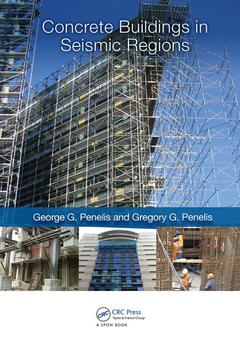Concrete Buildings in Seismic Regions
Auteurs : Penelis George, Penelis Gregory

Bearing in mind that reinforced concrete is a key component in a majority of built environment structures, Concrete Buildings in Seismic Regions combines the scientific knowledge of earthquake engineering with a focus on the design of reinforced concrete buildings in seismic regions. This book addresses practical design issues, providing an integrated, comprehensible, and clear presentation that is suitable for design practice.
It combines current approaches to seismic analysis and design, with a particular focus on reinforced concrete structures, and includes:
- an overview of structural dynamics
- analysis and design of new R/C buildings in seismic regions
- post-earthquake damage evaluation, pre earthquake assessment of buildings and retrofitting procedures
- seismic risk management of R/C buildings within urban nuclei
- extended numerical example applications
Concrete Buildings in Seismic Regions determines guidelines for the proper structural system for many types of buildings, explores recent developments, and covers the last two decades of analysis, design, and earthquake engineering. Divided into three parts, the book specifically addresses seismic demand issues and the basic issues of structural dynamics, considers the "capacity" of structural systems to withstand seismic effects in terms of strength and deformation, and highlights existing R/C buildings under seismic action. All of the book material has been adjusted to fit a modern seismic code and offers in-depth knowledge of the background upon which the code rules are based. It complies with the last edition of European Codes of Practice for R/C buildings in seismic regions, and includes references to the American Standards in effect for seismic design.
Introduction. An overview of structural dynamics. Design principles – seismic actions – performance requirements –compliance criteria. Configuration of earthquake-resistant R/C structural systems: Structural behaviour. Analysis of the structural system. Capacity design – design action effects – safety verifications. Reinforced concrete materials under seismic actions. Seismic-resistant R/C frames. Seismic-resistant R/C walls and diaphragms. Seismic design of foundations. Seismic pathology. Emergency post-earthquake damage inspection, assessment and human life protection measures. Seismic assessment and retrofitting of R/C buildings. Detailed seismic assessment and rehabilitation of R/C buildings. Technology of repair and strengthening. Seismic risk management. Index.
Gregory G. Penelis, MSc, DIC, Phd is the CEO of Penelis Consulting Engineers S.A., and has been involved in the design/review of more than 100 buildings throughout Europe.He has been involved in many research projects regarding the seismic assessment of listed and monumental buildings the urban nucleus.
George Gr. Penelis is Emeritus Professor in the Department of Civil Engineering at the Aristotle University of Thessaloniki, Greece, has served as national representative on the drafting committee for Eurocode 2, is ordinary member of Academia Pontaniana, Italy and has published more than 250 technical papers, and is co-author of Earthquake Resistant Concrete Structures. He has supervised 25 successful Phd theses.
Date de parution : 04-2014
Ouvrage de 876 p.
Disponible chez l'éditeur (délai d'approvisionnement : 13 jours).
Prix indicatif 195,46 €
Ajouter au panierThèmes de Concrete Buildings in Seismic Regions :
Mots-clés :
Response Spectrum; structural dynamics; Plastic Hinge; seismic actions; Ductile Walls; Safety Verifications; Elastic Response Spectrum; Reinforced Concrete design; Seismic Action; Seismic Pathology; Design Action Effects; Earthquake Damage; Safety Verification; Concrete Repair; Capacity Curve; Concrete Retrofitting; Shear Walls; Seismic Risk Management; Displacement Elastic Response Spectra; Modal Response Spectrum Analysis; Seismic Risk; Tie Beams; FRP Sheet; Elastic Acceleration Response Spectrum; Inter-storey Drift; FEMA; Design Seismic Action; Seismic Design Situation; Displacement Based Design Method; Warping Torsion; Federal Emergency Management Agency; SDOF System; SDOF Model; Model Correction Factor



